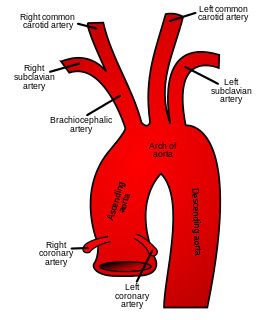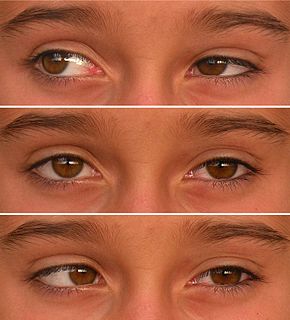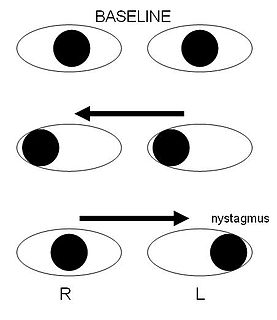
Marfan syndrome (MFS) is a genetic disorder of the connective tissue. The degree to which people are affected varies. People with Marfan tend to be tall and thin, with long arms, legs, fingers and toes. They also typically have flexible joints and scoliosis. The most serious complications involve the heart and aorta, with an increased risk of mitral valve prolapse and aortic aneurysm. Other commonly affected areas include the lungs, eyes, bones and the covering of the spinal cord.

Möbius syndrome is an extremely rare congenital neurological disorder which is characterized by facial paralysis and the inability to move the eyes from side to side. Most people with Möbius syndrome are born with complete facial paralysis and cannot close their eyes or form facial expressions. Limb and chest wall abnormalities sometimes occur with the syndrome. People with Möbius syndrome have normal intelligence, although their lack of facial expression is sometimes incorrectly taken to be due to dullness or unfriendliness. It is named for Paul Julius Möbius, a German neurologist who first described the syndrome in 1888.

In human anatomy, the subclavian arteries are paired major arteries of the upper thorax, below the clavicle. They receive blood from the aortic arch. The left subclavian artery supplies blood to the left arm and the right subclavian artery supplies blood to the right arm, with some branches supplying the head and thorax. On the left side of the body, the subclavian comes directly off the aortic arch, while on the right side it arises from the relatively short brachiocephalic artery when it bifurcates into the subclavian and the right common carotid artery.

A tic is a sudden, repetitive, nonrhythmic motor movement or vocalization involving discrete muscle groups. Tics can be invisible to the observer, such as abdominal tensing or toe crunching. Common motor and phonic tics are, respectively, eye blinking and throat clearing.

Hyperdontia is the condition of having supernumerary teeth, or teeth that appear in addition to the regular number of teeth. They can appear in any area of the dental arch and can affect any dental organ. The opposite of hyperdontia is hypodontia, where there is a congenital lack of teeth, a condition which is seen more commonly than hyperdontia. The scientific definition of hyperdontia is "any tooth or odontogenic structure that is formed from tooth germ in excess of usual number for any given region of the dental arch." The additional teeth, which may be few or many, can occur on any place in the dental arch. Their arrangement may be symmetrical or non-symmetrical.
Dressler syndrome is a secondary form of pericarditis that occurs in the setting of injury to the heart or the pericardium. It consists of fever, pleuritic pain, pericarditis and/or a pericardial effusion.

Arachnodactyly is a condition in which the fingers and toes are abnormally long and slender, in comparison to the palm of the hand and arch of the foot. Also, the individual's thumbs tend to be pulled inwards towards the palm. It can be present at birth or develop in later life.

Café au lait spots, or café au lait macules, are flat, pigmented birthmarks. The name café au lait is French for "coffee with milk" and refers to their light-brown color. They are also called "giraffe spots," or "coast of Maine spots," which refers to their jagged borders.

Crouzon syndrome is an autosomal dominant genetic disorder known as a branchial arch syndrome. Specifically, this syndrome affects the first branchial arch, which is the precursor of the maxilla and mandible. Since the branchial arches are important developmental features in a growing embryo, disturbances in their development create lasting and widespread effects.

Apert syndrome is a form of acrocephalosyndactyly, a congenital disorder characterized by malformations of the skull, face, hands and feet. It is classified as a branchial arch syndrome, affecting the first branchial arch, the precursor of the maxilla and mandible. Disturbances in the development of the branchial arches in fetal development create lasting and widespread effects.

Duane syndrome is a congenital rare type of strabismus most commonly characterized by the inability of the eye to move outwards. The syndrome was first described by ophthalmologists Jakob Stilling (1887) and Siegmund Türk (1896), and subsequently named after Alexander Duane, who discussed the disorder in more detail in 1905.

Internuclear ophthalmoplegia (INO) is a disorder of conjugate lateral gaze in which the affected eye shows impairment of adduction. When an attempt is made to gaze contralaterally, the affected eye adducts minimally, if at all. The contralateral eye abducts, however with nystagmus. Additionally, the divergence of the eyes leads to horizontal diplopia. That is, if the right eye is affected the patient will "see double" when looking to the left, seeing two images side-by-side. Convergence is generally preserved.

Goldenhar syndrome is a rare congenital defect characterized by incomplete development of the ear, nose, soft palate, lip and mandible. It is associated with anomalous development of the first branchial arch and second branchial arch. Common clinical manifestations include limbal dermoids, preauricular skin tags and strabismus.

DiGeorge syndrome, also known as 22q11.2 deletion syndrome, is a syndrome caused by the deletion of a small segment of chromosome 22. While the symptoms can vary, they often include congenital heart problems, specific facial features, frequent infections, developmental delay, learning problems and cleft palate. Associated conditions include kidney problems, hearing loss and autoimmune disorders such as rheumatoid arthritis or Graves disease.
Dermatoglyphics is the scientific study of fingerprints, lines, mounts and shapes of hands, as distinct from the superficially similar pseudoscience of palmistry.
Denys–Drash syndrome (DDS) or Drash syndrome is a rare disorder or syndrome characterized by gonadal dysgenesis, nephropathy, and Wilms' tumor.

Zunich–Kaye syndrome, also known as Zunich neuroectodermal syndrome, is a rare congenital ichthyosis first described in 1983. It is also referred to as CHIME syndrome, after its main symptoms. It is a congenital syndrome with only a few cases studied and published.
Congenital onychodysplasia of the index fingers is defined by the presence of the condition at birth, either unilateral or bilateral index finger involvement, variable distortion of the nail or lunula, and polyonychia, micronychia, anonychia, hemionychogryphosis, or malalignment.
A high-arched palate is where the palate is unusually high and narrow. It is usually a developmental feature that may occur in isolation or in association with a number of conditions. It may also be an acquired condition caused by chronic thumb-sucking. A high-arched palate may result in a narrowed airway and sleep disordered breathing.















